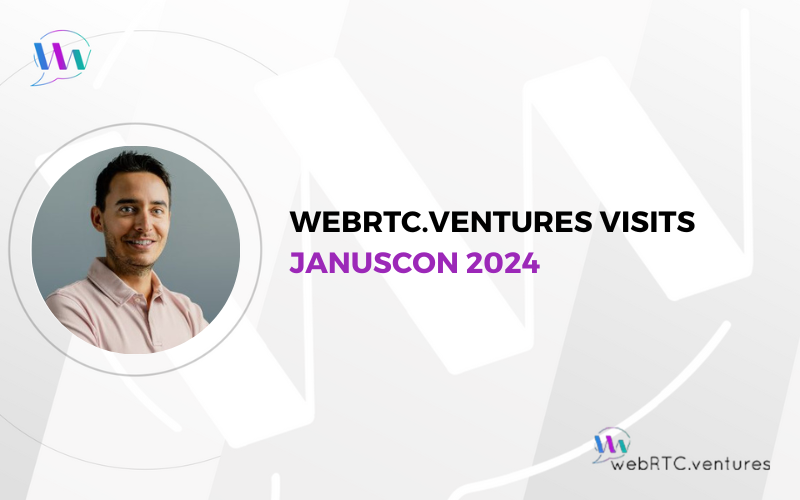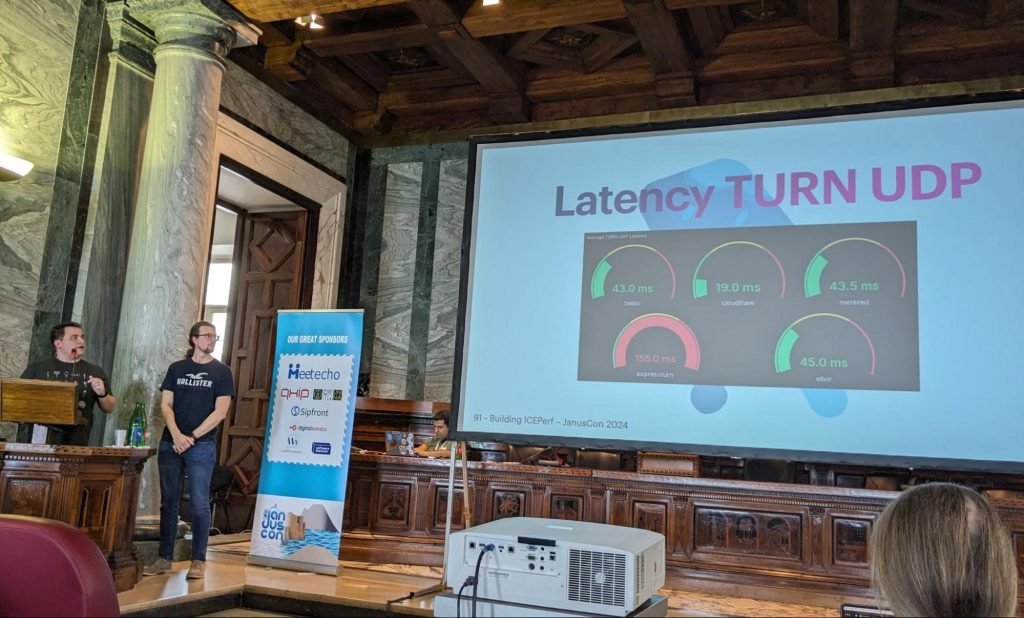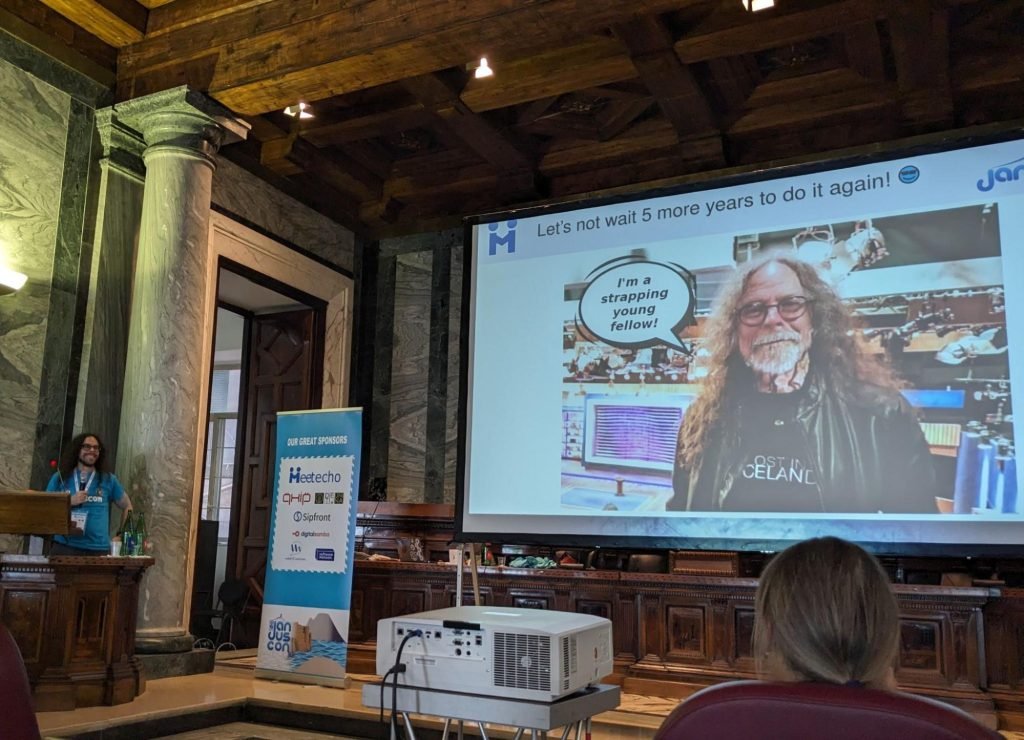The bustling streets of Naples and plentiful sunshine set the scene for an exciting start to the JanusCon 2024 conference, held at Centro Congressi Federico II. Amidst the chaotic morning traffic, I eagerly made my way to the venue, ready to delve into the world of RTC technology using Janus.

Day 1: Morning Highlights
The first day kicked off with a captivating overview of WebRTC fundamentals by Simon Pietro, setting the stage for in-depth discussions on scalability and monitoring. Lorenzo Mangani from telecom observability experts, QXIP, introduced powerful open-source frameworks like qryn, offering valuable insights into real-time observability and monitoring for platforms like Janus.
Andrei Leontev’s presentation on scaling and enhancing video communication platforms using Janus highlighted practical strategies for handling large user volumes effectively, including innovative approaches such as RTP forwarding from Janus videoroom to streaming plugin elements.
Denis Sicun’s talk on Kaltura’s transition from startup to enterprise with Janus showcased key improvements and strategies for leveraging Kubernetes and HTTP signaling and simulcast, Denis shared key insights into the journey of growth and transformation.
Robert Strobl’s exploration of the VPaaS revolution shed light on the evolving landscape of real-time communication platforms. He shared Digital Samba’s new high level video SDK.
Paolo Saviano’s discussion on building multi-purpose Real-Time CDNs with Janus provided valuable insights into infrastructure optimization and media server scalability.
Day 1: Afternoon Highlights
Day 1’s early afternoon sessions showcased groundbreaking talks by industry experts: Wojciech Barczyński of Software Mansion discussed optimizing React for live streams, while José Aguerre from Evercast introduced Pixelweave Chromascale, a GPU-based video frame conversion library. These talks offered invaluable knowledge on real-time communication advancements.
The final talks of the day offered a glimpse into popular Janus-related projects and an overview of the business side in tech. Dominik Ridjic of Sipfront discussed automating WebRTC test calls, while Alessandro Toppi showcased Janode’s capabilities from his vantage point as a Meetecho WebRTC architect. Celeste Mangani provided strategic insights, business tools and the possibility to gain the knowledge and skills to achieve a deeper understanding of projects.
Day 2 Highlights
The second day of the conference saw a deep dive into the realm of AI and real-time media processing. Attendees were treated to a presentation by Evan McGee from SignalWire, offering an overview of the current state of speech-to-text technology. Evan discussed SignalWire’s approach to avoiding audio hallucinations and highlighted the multidimensional nature of speech compared to text.
That morning, I had the pleasure of presenting on integrating WebRTC apps with LLMs (Large Language Models) and LAMs (Large Action Models). I shared insights into leveraging Janus in real-time applications and provided a sneak peek into the technology behind LAMs. View the slides from my presentation here. And, find relevant demo projects here and here. (I will be talking more about this in a future blog post. Stay tuned!)
Jitsi then took the stage to share their experience in building agents for meetings, challenging the notion of real-time bots and emphasizing the prevalence of private, asynchronous assistants. Saúl Ibarra Corretgé provided insights into the future of meetings integrations. He introduced Skynet, Jitsi’s open-source wrapper for performing AI operations like speech-to-text and summaries.
Dan Jenkins presented on measuring ICE performance and offered practical insights about how to measure it. Learn more about this project here. (Dan was Arin’s guest on WebRTC Live last month. Check it out!)
Later, Tim Panton from pi.pe explored WebRTC-based cameras for car racing and showcased the challenges and innovative solutions in this niche domain.
Răzvan Crainea’s session on enabling VoLTE/VoNR in IMS provided valuable insights into integrating RTC technology into telecommunications infrastructure. Javi B, a leading educator in video coding at Pompeu Fabra University, presented on the history and future of piracy in broadcasting, shedding light on industry challenges and sharing some original ideas about how to overcome them.
Thank you for your hospitality, Lorenzo! We agree, let’s not wait 5 more years to do it again!
Janus holds such significance for us at WebRTC.ventures. It was truly a pleasure personally to present and for our company to sponsor the JanusCon conference.
It was also a treat to connect with so many colleagues to share ideas and explore the latest advancements in RTC technology.
Overall, the conference provided a platform for attendees to explore emerging trends and collaborate on addressing key challenges in the field of Real-Time Communications. From discussions on scalability and monitoring, to explorations of AI and media processing, the conference showcased the diverse applications and potential of RTC technology.
















